About the Blog: Khajuraho is one of the most famous tourist destinations in India. The temples of Khajuraho are undoubtedly one of the best in terms of temple architecture in India. The temples of Khajuraho are divided into three parts – the western, eastern and southern group of monuments. This blog is an effort to document the archaeological monuments in Khajuraho after our visit there. Read further to know about the temples of Khajuraho and other monuments in these three groups, and other relevant information like how to reach and where to stay in Khajuraho.
If there is one place in India that piques interest in both domestic and international tourists, it has to be Khajuraho. The temples of Khajuraho, known for their erotic sculptures and carvings have generated curiosity among a lot of tourists around the world. But Khajuraho is much more than the explicit erotic sculptures. The temples of Khajuraho are one of the best examples of medieval temple architecture in India. They are undoubtedly the most extraordinary archaeological site in the country.

Khajuraho is a small town located in the Chhatarpur district of Madhya Pradesh. The temples of Khajuraho have been declared a UNESCO World Heritage Site and is one of the most popular tourist destinations in India. While some come here to find a correlation between the Kamasutra and the temples of Khajuraho, there are others who come to look at the erotic structures and think as to why there are such carvings on a temple. And then there are a few who come to marvel at the exquisite architecture of the temples, the exceptional craftsmanship and the visual treat that the temples of Khajuraho have to offer.
Temples of Khajuraho – A Brief History
The temples of Khajuraho were commissioned by the rulers of Chandela Dynasty sometime between 900 AD to 1100 AD. The Chandelas belonged to the Rajput clan and the dynasty was founded by Nannuka (831 – 845 AD). They were actually feudatories of the Gurjara-Pratihara Empire, who ruled majority of Northern India from Kanauj. The Chandelas supported the Gurjara-Pratihara rulers in return for security against the aggression of the Muslim invaders.

This period provided peace and was one of the golden periods of temple architecture in medieval India. According to an inscription found, Nannuka ruled from a place known as Khajurwatika, which later came to be known as Khajuraho. Khajurwatika was a flourishing temple town. It is believed that once there were about 85 temples in Khajuraho within an area of 13 sq km.
Reminded of the Temples of Maluti? Read our blog on Maluti, the temple town of Jharkhand.
By the 13th century, Khajuraho and the Chandela dynasty had fallen into decline. It can be seen from the less impressive temples built during that period. It seems likely that the individual temples of Khajuraho were associated with specific rulers of the Chandela dynasty.
After the decline of the Chandela dynasty, Khajuraho remained as a religious center till the 14th century. Mention of Khajuraho was found in the memoirs of Arab traveller Ibn Batuta who visited the area in 1335.
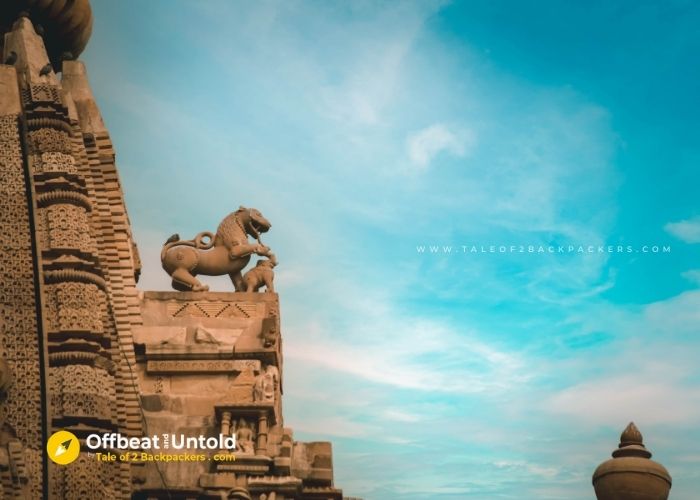
By the 16th century, Khajuraho seemed to have gone completely off the radar. No reference of this place was found in any Mughal records. Perhaps this is the reason why this temple town escaped massacre and destruction from the hands of the Muslim invaders.
Khajuraho was brought back to life by Lieutenant William Price in 1813 when he reported a Sanskrit inscription found at Mau near Khajuraho. By 1818, the temple town of Khajuraho was once again in the news drawing the attention of historians.

In 1838, Captain T S Burt published the first modern account of the Western Group of Temples. He understood the importance of such a high concentration of temples in a small region and started noting down the inscriptions. Later, between 1843 and 1847, Maharaja Pratap Singh carried out excavations and renovations of the temples of Khajuraho. He was the first local ruler to take interest in the Khajuraho temples.

The most comprehensive accounts of the temples of Khajuraho as done by Major Alexander Cunningham, the Archaeological Surveyor to the Government of India, who visited the area in 1852, 1864 and 1865. He was also known as the father of Indian archaeology.
Currently the Khajuraho Temples are under the charge of the Archaeological Survey of India.
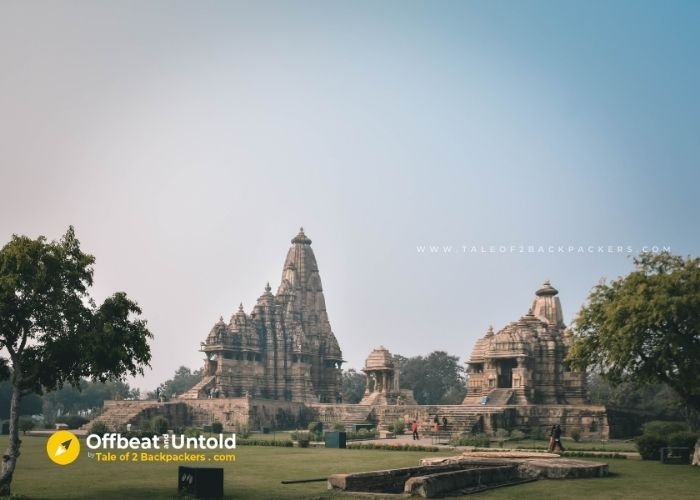
Architecture of the Khajuraho Temples
The Khajuraho Group of Temples follows the Nagara style of architecture. In actuality, these temples demonstrate the pinnacle of temple architecture of the period. The temples built in sandstone are elevated on an ornate terraced platform (jagati). The sanctum is topped by a heavily carved Shikhara or tower, unique to the Nagara style of architecture. The principal spire is flanked by a series of miniature spires, making it more prominent. Each miniature spire symbolizes Mount Kailasa, the abode of Lord Shiva.

The entrance of the temple is through a decorated entrance porch (Ardha mandapa) leading to the main hall (mandapa). After that you can access the vestibule (antaralaya) and then to the main sanctum (garbhagriha).
The sculptures of the temples of Khajuraho are harmoniously integrated with the architecture of the temples. All the surfaces of the temples are carved with both human and non-human motifs depicting sacred and secular themes.

There are sculptures depicting deities and gods, nymphs, acts of prayer and other sacred beliefs. There are sculptures depicting kings and queens, warfare and the social fabric of the time like many other temples in India. Scenes of domesticity, marriages, teacher and student, musicians and dancers and so many more are also found in the temples of Khajuraho.
And then there are the erotic sculptures that Khajuraho is so known for.
Erotic Sculptures of Khajuraho
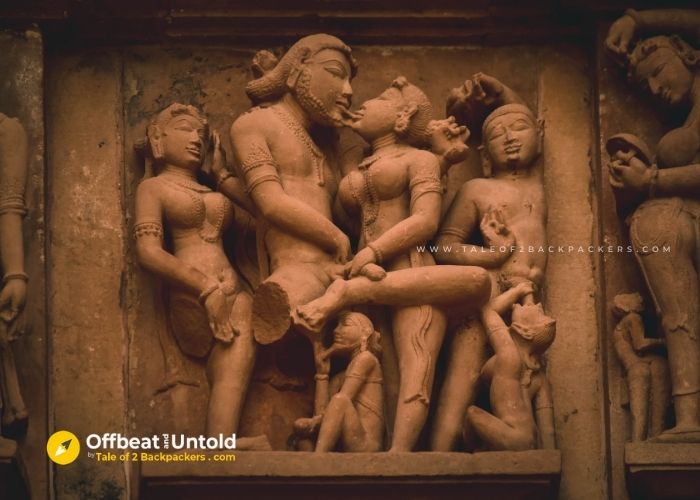
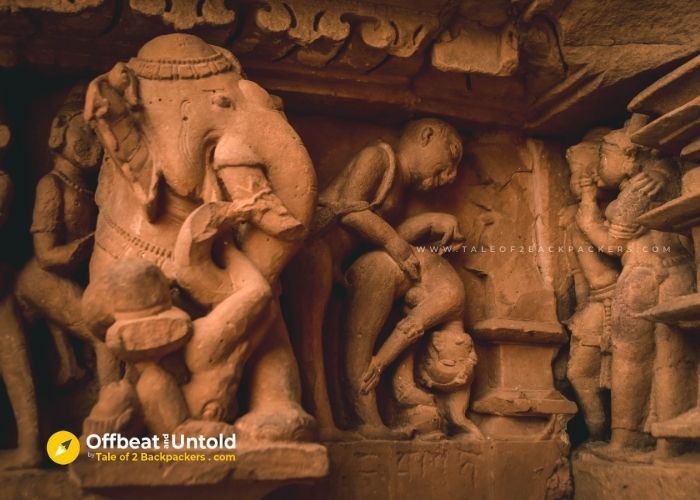



There are sculptures of amorous couples. And then there are erotic sculptures that include men and women, threesomes and orgies, bestiality and even animals. These are definitely not for the prudes. However, the erotic sculptures of Khajuraho comprises only 10% of the entire carvings. The erotics carvings are also not found in the interior of the temples.
Temples of Khajuraho – Khajuraho Group of Monuments

Out of the 85 temples of Khajuraho, only 26 survive today. These temples are divided into three distinct groups – the Western, eastern and southern groups. The western group of temples are the largest and the most well preserved and is recognised as the UNESCO World Heritage Site. This group also consists of the most famous and the important temples – Kandariya Mahadev Temple, Lakshmana Temple, Vishwanath Temple and others. If there is a crunch of time, then you must concentrate on this group only.
YOU MAY ALSO LIKE: Sun Temple in Konark, Poetry in Stones
All these temples of Khajuraho are spread within an area of 6-7 sq km only. These temples are dedicated to Shiva and Vishnu, Ganesha, Sun God and some to Jain Tirthankaras. While you can visit all these temples in one day, we recommend you to split your Khajuraho itinerary over two days. Keep the first day to explore the Western Group of Temples and the second one for eastern and southern groups.
Western Group of Temples
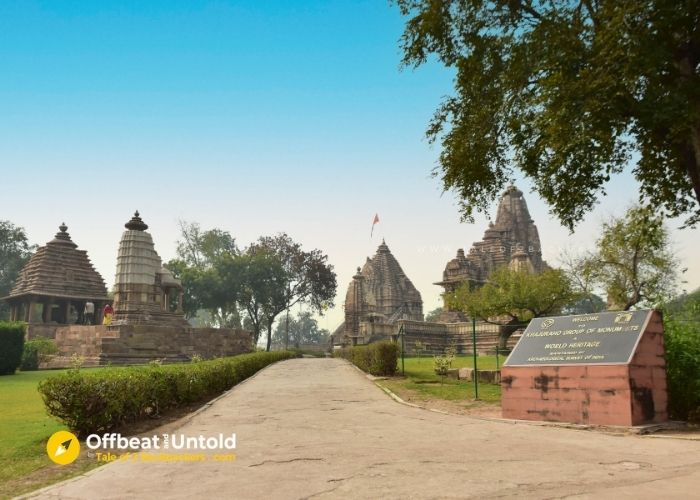
The Western Group of Temples are the most impressive ones with imposing architecture and exquisite sculptures and carvings. It is here where you will find the famous erotic sculptures of Khajuraho on display.
There are 15 monuments in total in the Western Group of Temples. Out of them 10 are located inside the compound managed by ASI. There is an entry fee to enter the compound. The remaining five are outside the compound and are free to visit.
Visit the temples inside the compound first and then you can visit the rest 5, which are within walkable distance from the western compound.
1. Lakshmana Temple

Lakshmana Temple is grand and the first one you will probably see inside the compound. This temple was constructed between the period 930 to 950 AD. Although it is not one of the largest temples of the complex, the carvings on the internal and external walls are simply stunning.

The exterior walls are divided into two distinct zones having sculptures of griffins, snake goddesses, apsaras and amorous couples in the recesses. The upper zone depicts different forms of Vishnu and the lower one focuses on Shiva.
The erotica are found mainly in the recesses between the external walls of the assembly hall and the sanctuary and are quite agile in nature depicting complex coitus positions.


2. Varaha Temple
Varaha Temple is located directly opposite the Lakshmana Temple facing the east. This is believed to be one of the oldest temples in the complex built somewhere around 900 – 925 AD. The shrine consists of an oblong pavilion with a pyramidal roof resting on 14 pillars. The ceiling is carved with a lotus flower.


Inside the shrine is a sandstone carving of Varaha or boar. Varaha is the third Avatar of Lord Vishnu. The highly polished boar is massive, over 2.5m in length and is carved out of a single rock. On the surface of the boar, there are 675 small figurines carved in twelve rows. These figurines represent various Gods and Goddesses of Hindu pantheon.
3. Kandariya Mahadev Temple

Kandariya Mahadev Temple is one of the grandest monuments not only in Khajuraho, but also in India. Dedicated to Lord Shiva, the temple is believed to have been built around 1030 AD. It is also the largest and tallest of all the temples of Khajuraho. The temple got its name from the word “Kandara” meaning cave.
The main Shikhara or spire of the Kandariya Mahadev Temple has 84 subsidiary spires! It looks like a cascading waterfall. The exterior of the temple has exquisite carvings of Lord Shiva, Dikpalas, griffins, snake goddess and apsaras.


Kandariya Mahadev Temple also has some of the most explicit erotica found in the temples of Khajuraho. Just like the Lakshmana temple, these erotic sculptures are found in the external recesses between the sanctuary and assembly hall. The erotica includes amorous couples, orgies and some very acrobatic sexual poses.

The interior of the temple also has some exquisite carvings and sculptures.
4. Mahadev Shrine
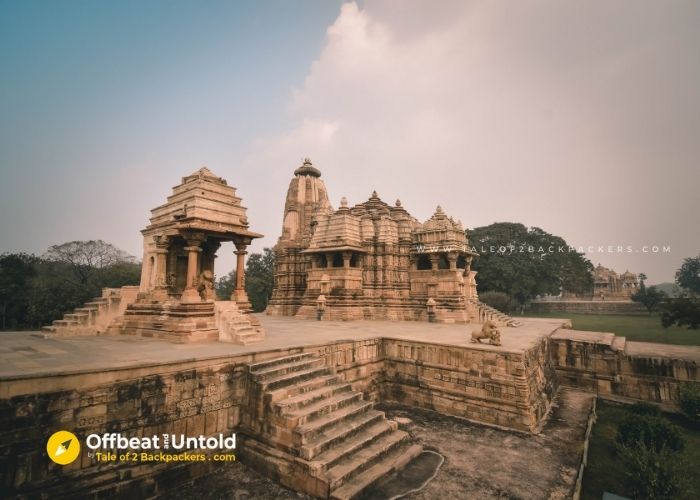
Mahadeva Shrine is a smaller temple in between the Kandariya Mahadev Temple and the Jagdambi Temple. All three temples share the same platform. This temple seemed to be a ruined one having only the entrance porch. The inner sanctum has completely disappeared.
5. Jagadambi Temple

Jagadambi Temple is believed to have been built around 1000 to 1025 AD and shares the same platform as the Kandariya Mahadev Temple and the Shiva shrine. This temple, though less elaborate than the Kandariya Mahadev Temple, has some elegant sculptures on the walls. This temple also has several erotic sculptures on the exteriors.

6. Chitragupta Temple
This temple was built during 1000 to 1025 AD having a similar design to the Jagdambi Temple. This is the only surviving temple in Khajuraho dedicated to the Sun God. This temple also has beautiful carvings of deities, apsaras and erotic sculptures as well.
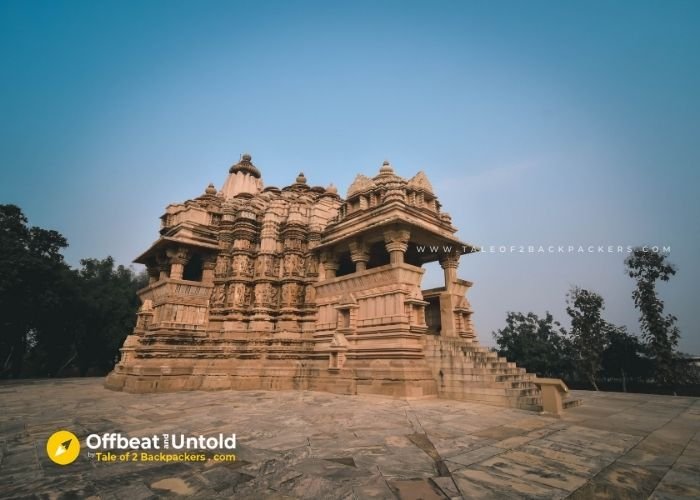
Inside the temple is a huge idol of Sun God, Surya, almost 2m tall. The hands of the statue are broken off. The Sun God is usually portrayed riding seven horses. If you look at the base of the idol, you can just find out the outline of horses driven by a charioteer.
7. Parvati Temple

A short distance away is a small shrine known as the Parvati Temple. The temple houses the image of Goddess Parvati.
8. Vishwanatha Temple

The Vishwanath Temple is located on the eastern side of the compound and is one of the grandest temples of Khajuraho. Out of the four subsidiary shrines surrounding the temple, only two survived. Like all the other temples in the compound, this also has quite beautiful sculptures. On the north side in between the juncture of the maha mandapa and sanctum, there are panels showing erotic scenes.

9. Nandi Temple
Nandi Temple is located just opposite the Vishwanath Temple facing each other on the same plinth. Inside the temple, there is a beautiful statue of the bull, Nandi, also known as Lord Shiva’s carrier.

10. Pratapeshwar Temple
The Pratapeshwar Temple looks different from the rest of the temples in the compound. It is because this temple is the newest one built almost 800 years after the rest of the temples in the compound. The Pratapeshwar Temple is actually the Chhatri or the memorial of Raja Pratap Singh who built this temple as a memorial of himself to immortalize his name.

This temple will either be the first or the last temple that you will encounter inside the compound depending on which direction you decide to take a circular route around the western group complex.
The architecture of the Pratapeshwar Temple is an interesting conglomeration of three styles. It has a Rajputana dome in front, a pagoda ceiling and a typical Shikhara at the back.
11. Bhairav Statue

Bhairav Statue is located on the way to the Matangeshwar Temple outside the fenced enclosure of the Western group of temple complexes. The statue is almost 2m high and is coated with red lead. This orangish read coating is perhaps done much later. Bhairav is the fierce form of Lord Shiva. However, this Bhairav statue does not look fierce at all. This is technically not a temple, but perhaps it was a part of another elaborate temple in Khajuraho.
12. Matangesvara Temple

Matangeshwar Temple is the main temple in the Western Complex that is still in use. It stands just next to the Lakshmana Temple, but outside the fenced enclosure. There is a narrow lane leading to the temple. Matangeshwar Temple is believed to have been built around 1000 AD.
Since this is an active temple, we found many devotees offering prayers in the temple, even early in the morning. Later when we came back after visiting the western compound, it was still busy. During Shivaratri, a huge ceremony is held at this temple for 3 days.
13. Chausath Yogini Temple

After visiting the Chausath Yogini Temple at Morena, I was quite intrigued when I heard that there is a Chausath Yogini Temple at Khajuraho as well. This temple is situated away from the rest of the western group of temples. This is considered to be one of the oldest shrines in Khajuraho dating back to 885 AD.
Like the other Chausath Yogini Temples, this temple also has several cells . But while the other yogini temples are circular in nature, the Chausath Yogini Temple of Khajuraho is rectangular. Of all the Chausath Yogini temples in India, this one has the most primitive construction.

The Chausath Yogini Temple initially had 67 cells, out of which only 35 survive now. All the cells are of equal size except one. There is an image of Goddess Durga Mahishasuramardini inside the largest cell. The Goddess is labeled as Hinglaj here. Right now, the cells of the Chausath Yogini Temple are bereft of any images of Goddess.
14. Lalguan Mahadev Temple
Lalguan Mahadev Temple is located on the banks of the Lalguan Sagar Lake, almost 600 m west of the Chausath Yogini Temple. This temple is dedicated to Lord Shiva. The temple is dated back to 900 AD.
Lalguan Mahadev Temple is quite remote and we lost our way while reaching it. There is a straightforward path from the Chausath Yogini Temple to this one, but we somehow went in the wrong direction. We had to take the help of a few locals and then could find this small temple.
15. Chopra Tank

The Chopra Tank is located just outside the Western Temple complex north of the Chitragupta Temple. The tank lies in the middle of a wasteland, albeit enclosed by a wired fence. When we visited there almost in the evening, the gate was closed and there were no guards to open the gates. But the fence was already worn down and we could easily climb over the fence and go inside the field to take a few pictures of the Chopra Tank. A few local youngsters also went inside with us.
The tank is totally in a ruined condition and seems abandoned. Even though the Chopra Tank is located close to the Chitragupta Temple, reaching there takes quite a bit of time through the main road.
So those were the temples and shrines of the Western Group of Monuments in Khajuraho. If you are short of time, you can only visit the ones inside the compound and the Matangeshwar Temple and Bhairava Statue. For us, I had a special interest in the Chausath Yogini Temples of India and so went on to visit that. And then did not want to miss the other two as well.
We had explored the Western Group of temples on our first day of Khajuraho trip. The next day was dedicated to the eastern and southern group of monuments.

The Eastern Group of Monuments
The eastern group consists of 8 temples and are located a little distance away from the main Khajuraho town. While these can be done on foot, some form of transport is recommended.
16. Hanuman Temple
Hanuman Temple is located on the Jain Road to the west of Khajuraho. The shrine is newly constructed, but the 2.5m high idol of Hanuman dates back to 922 AD. There is an inscription on the pedestal that states year 316 of Harsha era. This makes this Hanuman statue one of the earliest inscribed statues of Hanuman found in India. It is for this fact we wanted to see the Hanuman Temple on our Khajuraho Temple trip.
Like the Bhairav statue, the idol of Hanuman is painted in red. The temple is an active one with people offering their prayers throughout the day.
17. Brahma Temple
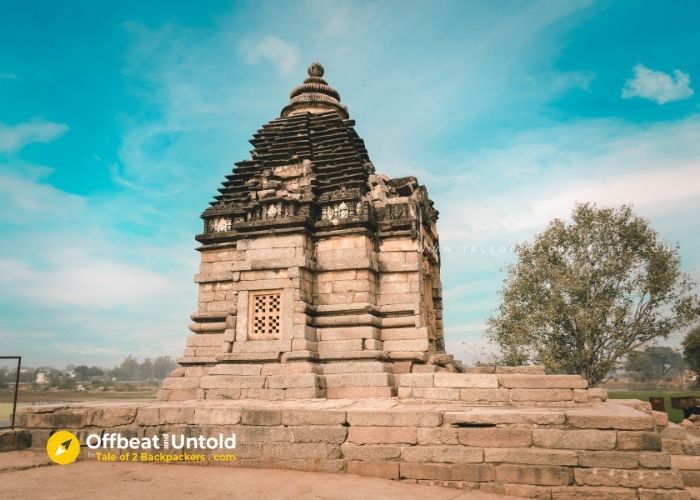
This is perhaps one of the most interesting temples we found in the eastern group of Monuments. Located on the banks of Khajur Sagar tank, the temple looks quite simple devoid of any ornate carvings.
The temple was originally dedicated to Lord Vishnu as it is evident from the image of the God on the centre of the lintel. It also has the images of Ganga and Yamuna on both sides as found in many temples of Vishnu.
Inside the temple there is a Shiva Linga having four faces on its four sides. This type of Shiva linga is known as Mukhalinga. It has four or five faces of Lord Shiva carved on the faces. The faces represent the five forms of Lord Shiva.

This four-faced Mukhalinga is mistaken for the four face of Lord Brahma and the temple is thus known as Brahma Temple. This aspect of the temple really fascinated us.
18. Vamana Temple
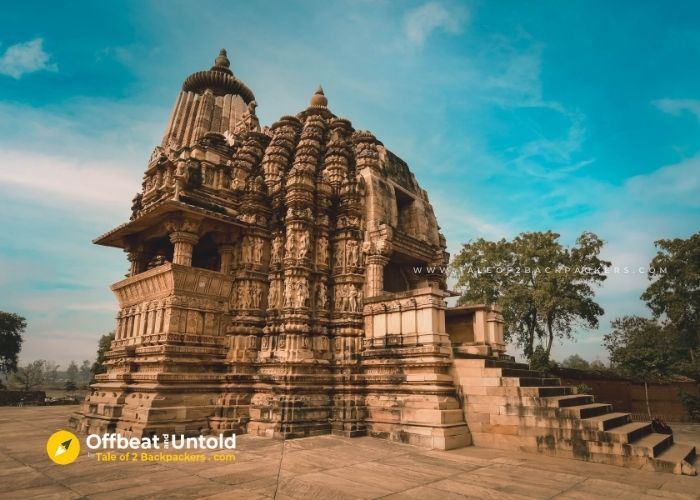
Just 200m northeast of the Brahma Temple lies the Vamana Temple, dedicated to Vamana, the fifth incarnation of Lord Vishnu. The Vamana Temple has some of the most intricate carvings that can be found in the temples of Khajuraho. This temple has very little erotica. You will find the classic Khajuraho sculpture of a woman extracting thorn from her feet in this temple.
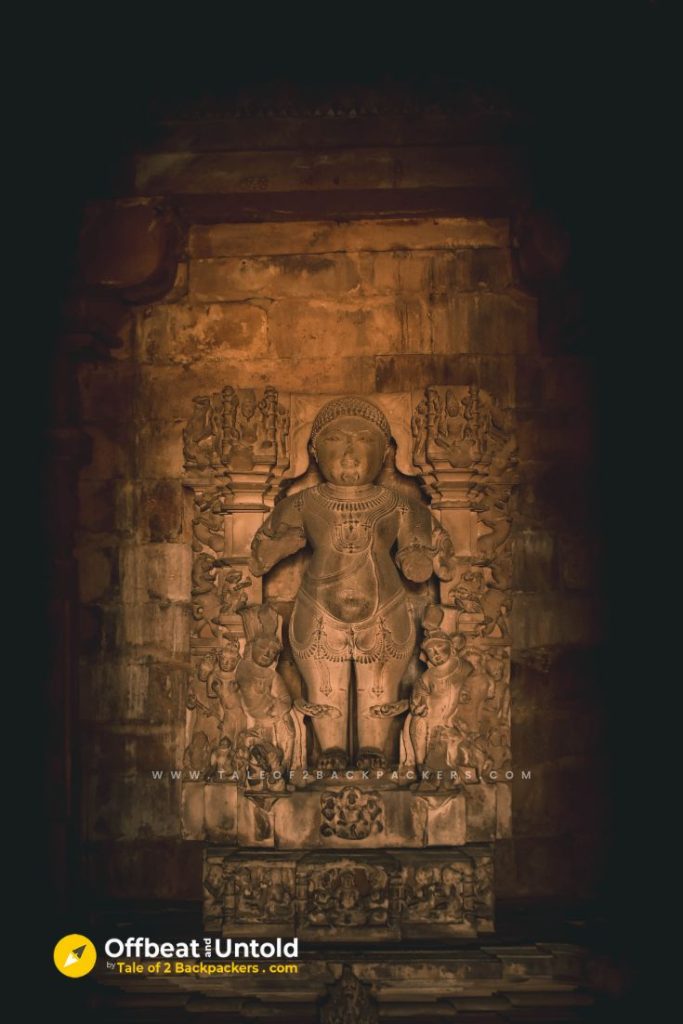
Inside the temple, there is an idol of Vamana, the dwarf incarnation of Vishnu. The temple is believed to have been built between 1050 to 1075 AD.
19. Javari Temple

Javari Temple is located about 200 m south of the Vamana Temple and is dedicated to Lord Vishnu. This temple is surrounded by green fields and trees. The temple is small, but beautiful having a soaring Shikhara.

There are ornate carvings on the exterior of the temple. Inside the sanctum there is a headless idol of Lord Vishnu. The ceilings of the temple are beautifully carved. So, do not forget to look up. This temple is believed to have been built around 1075 to 110 AD.
20. Ghantai Temple

Ghantai Temple is located about 350m south east of the Brahma Temple in the southern part of Khajuraho on the road towards the cluster of Jain Temples. The temple is in ruins and only a few pillars and ceiling remain. There are several mounds around the ruin waiting to be excavated.

The temple is believed to have been built around 995 AD during the rule of Chandela king Dhanga and is a Jain temple. Some of the carvings in the temple point to Jain Goddess Chakreshwari, which further implied that the temple was dedicated to Adinatha. The pillars in the temple have elegant carvings.
21. Adinatha Temple
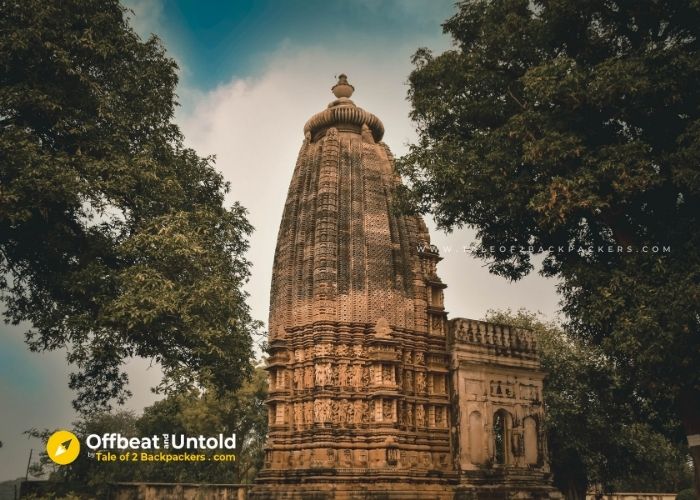
Adinatha Temple is one of the three Jain temple clusters in the eastern group of monuments in Khajuraho. The design of the temple is quite similar to that of the Vamana Temple. The walls of the temple have beautiful sculptures, mainly of apsaras in classical dance poses.
The temple also has carvings of both Hindu and Jain deities. Inside the temple, there is a black idol of Lord Adinatha.
22. Parshvanatha Temple

Unlike the other two, Parasvanath temple is quite decorated and is considered one of the finest temples of Khajuraho. The temple was built around 960 AD. The exterior of the temple is beautifully carved with sculptures of apsaras applying makeup, musicians and many more.
There is another shrine dedicated to Lord Adinatha at the back of the main temple.
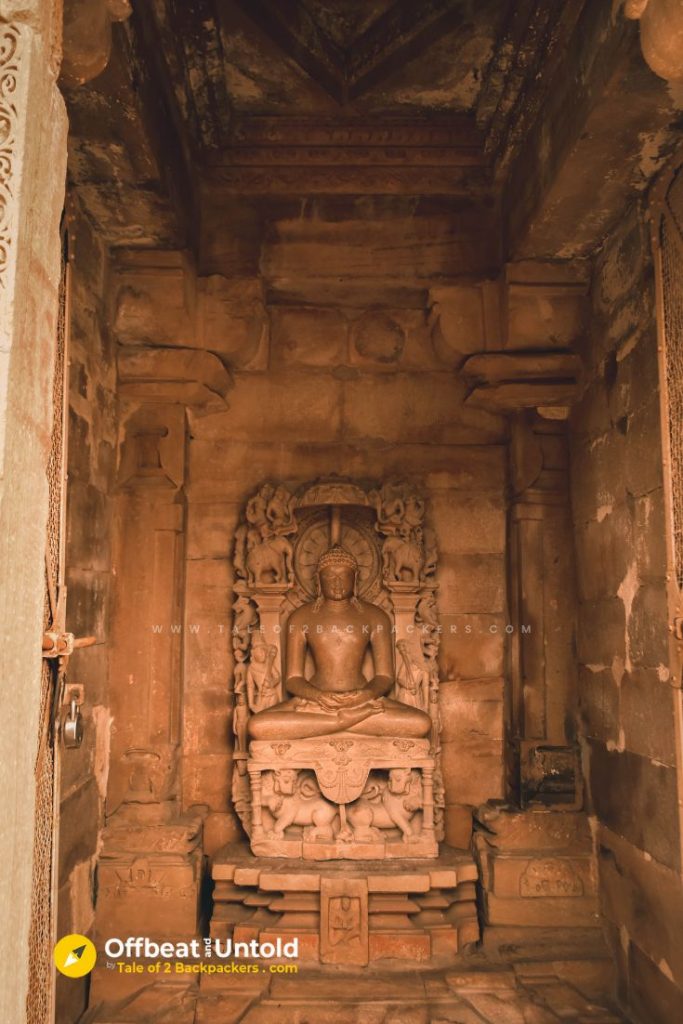
The interiors of the temple also have some beautiful carvings. Once again, look up at the ceiling and you will be surprised. There is an idol of Lord Parasvanatha inside the main sanctum.

23. Shantinatha Temple
Shantinatha Temple is the main Jain temple in Khajuraho and is also an active place of worship. This is not a single temple, but a cluster of temples, some modern shrines and some dating back to almost 1027 AD. This temple reminded us of the Jain temples we saw in Murshidabad, West Bengal.

The main sanctuary has a majestic statue of Lord Adinatha, 4.3m high. There are some old sculptures inside the complex as well.
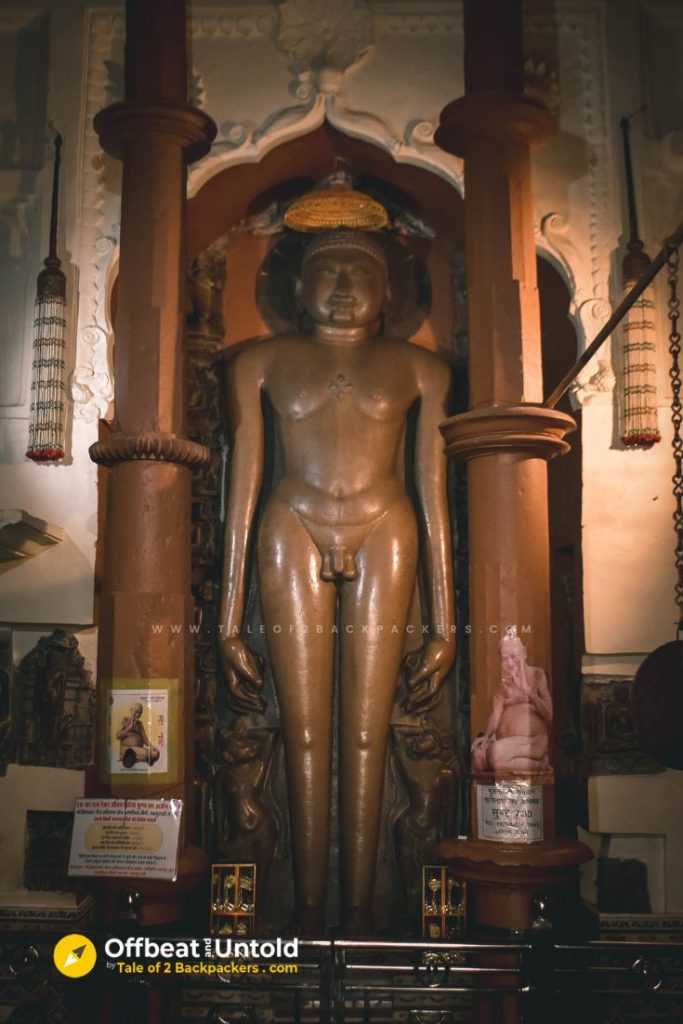
Southern Group of Monuments
The Southern Group of Monuments contain 3 monuments and are most dispersed.
24. Duladeo Temple

Duladeo Temple is located about 700m southwest of the Jain cluster of temples. This temple was believed to be built around 1130 making it one of the last temples to be built in Khajuraho. Duladeo Temple is dedicated to Lord Shiva.

The linga inside the temple is a Sahashra linga, meaning there are 999 lingas carved around the surface of the main linga.
25. Chaturbhuj Temple

The Chaturbhuj Temple is located in Jatkari village to the south of Khajuraho. The temple has been restored as seen from its structure and carvings. It is believed to have been built around 1100 AD.
The interior of the temple is simply stunning with exquisite carvings and sculptures. Inside the sanctum, there is a four-armed statue of Vishnu, which looks quite majestic. I heard that at 4:30 pm the Vishnu idol is directly hit by the falling sun rays making the place quite magical. While we did not get a chance to witness this magic, I hope you do.
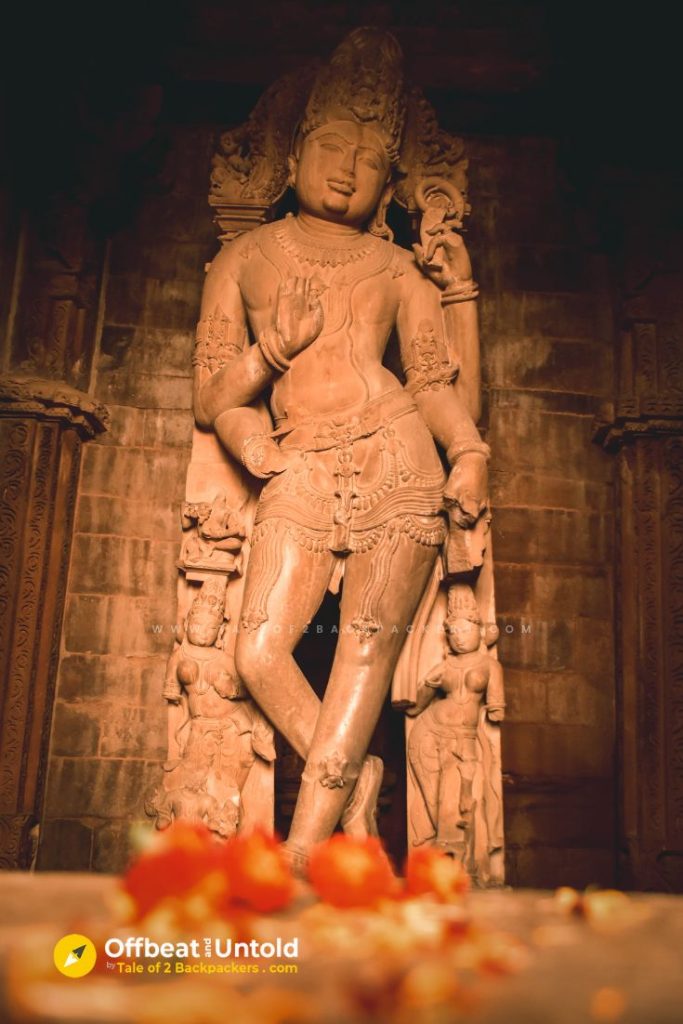
26. Bijamandal
Bijamanadal is essentially an excavation site. We really had a tough time locating it, as most of the locals also could not point it out. It is located just outside the Jatkari village, near the Chaturbhuj Temple. The site was opened only in 1999 and has been only partially excavated.
Excavations during 2002-2003 revealed the lower remains of a temple structure, probably dating back to 10th – 11th century AD. It seemed that this temple would probably have been the largest temple in Khajuraho, even bigger than the Kandariya Mahadev Temple.

A large number of idols of Shiva, Vishnu, Brahma and nymphs and apsaras have been excavated from the Bijamandal site. An image of Saraswati had also been excavated which can be now found in the museum. There are numerous statues and idols all scattered around the mound.
So, those were the temples of Khajuraho. While the Western Group of Monuments are the most impressive ones, I found the others quite interesting as well. Since we had an interest in these temples of Khajuraho, we ended up exploring all of these. If you have less time or temples do not interest you, then you can opt to visit only the Western Group. Or, you can choose which temples you want to visit and plan accordingly.

Other Things to do in Khajuraho
There are few other things to do around Khajuraho as well.
Visit the Museums
There are two museums in Khajuraho. The old museum is located in front of the Western group of Temples and is quite small. There is another one about 500 m away from the Western group of temples in Khajuraho, it has a good collection of sculptures.
There is also a Tribal and Folk Art Museum with a collection of paintings, sculptures and artifacts. This museum will give you an insight about the tribal culture of the area.

Sound And Light Show
This is the quintessential Sound and Light Show when the temples are beautifully illuminated in the evening and the narrator tells you stories about Khajuraho and its history. The Sound and light Show takes place every evening after sunset for about an hour. The show is available in both English and Hindi.
Entry Fee: INR 250 for Indian tourists and INR 750 for foreign tourists.
Time: October to February: 6.30 – 7.25pm in English and 7.40 – 8.35pm in Hindi
March to September: 7.30 – 8.25pm in English and 8.40 – 9.35pm in Hindi
The Sound and Light Show does not take place during Khajuraho Dance Festival that usually takes place in February. Similarly, bad weather conditions also play a dampener.
Explore the villages
While the temples of Khajuraho are its main attractions, the countryside is equally beautiful. You can rent a bike and explore the village. The eastern group of temples are scattered around the villages. So, you can rent a bike and explore the rural beauty of Khajuraho.
Attend a Folk Dance Show
Folk Dance show is held every evening at the Kandariya Art and Cultural Centre in Khajuraho. If you are interested in performing arts and want to do something different from exploring the temples of Khajuraho, you can attend one of these shows.
Go for a day trip to Panna National Park and Raneh Waterfall
Panna is one of the famous national parks of Madhya Pradesh and is one of the newest one in the country. The region is a dry deciduous forest having vast grasslands well suited for spotting wildlife. You can do this as a day trip from Khajuraho. Even if you are unable to spot a big cat, you will probably get a view of wild animals like chital, wild boars, Sambhar, Chinkara and leopards. Several species of birds are also spotted at Panna National Park.
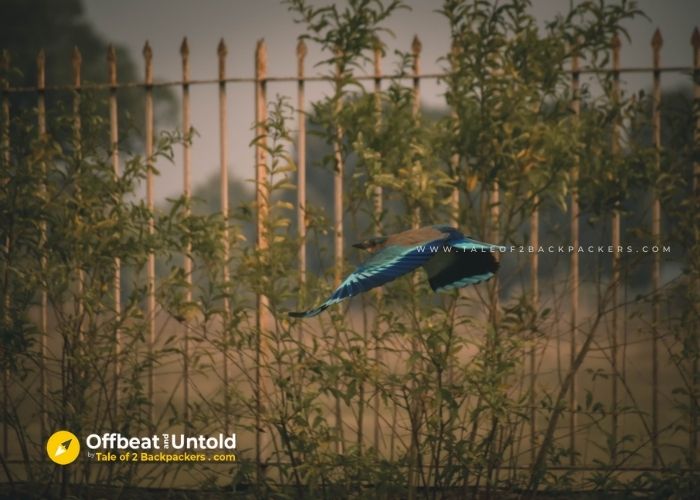
You can go for morning safari (usually 6.30 am to 11.00 am) or evening safari (3.00 pm to sunset).
Raneh Waterfall is located about 20 km from Khajuraho in the forest reserve of Panna National Park. The Ken River flows through the canyons making the waterfall quite gorgeous. Raneh Waterfalls is best viewed after the monsoons.
There is another waterfall inside the reserve area of Panna- the Pandav Waterfall, named after the Pandava brothers of Mahabharata. This is also a beautiful waterfall, viewed best after the monsoon.
Temples of Khajuraho – Travel Guide
How to Reach Khajuraho?
Khajuraho is well connected by air, train and bus from the majority of the cities in Central and North India.
Khajuraho has an airport, connected by flights from Delhi and Varanasi.
It also has a railway station and is connected by trains from New Delhi, Varanasi, Kanpur, Indore, Bhopal and Jhansi.
Jhansi is the major railway station near Khajuraho, located about 175 km away.
There are buses available from Gwalior, Jhansi and Chhatarpur to Khajuraho.
You can also hire a private car from Jhansi to Khajuraho.

Getting Around Khajuraho
Khajuraho is a small place and most of the temples of Khajuraho are concentrated within a small area. You can simply walk around if you want to explore the Western Group of Monuments.You can hire a rickshaw or Tuk-tuk to travel to the other areas.
You can also rent bikes and bicycles in Khajuraho for a day to explore the place. We had rented a scooty for a day to explore the eastern and southern group of monuments and the villages around Khajuraho.
Where to Stay in Khajuraho?

Khajuraho is a small place and most of the hostels and hotels are concentrated around the Western group of Temples. There are stay options catering to all budgets in Khajuraho.
Budget
- Zostel Khajuraho
- Friends in Khajuraho Homestay
- Hotel Ramayana
Mid-Budget
- Hotel Isabel Palace
- Hotel Harmony
- Bundela Resort
Luxury
- Lalit Temple View
- Clarks Khajuraho
- Radisson Jazz
- Ramada Khajuraho
What is the best time to visit Khajuraho?
The best time to visit Khajuraho are the winter months between November to February. During this time, the weather remains cool. The maximum temperature remains between 16 to 18 degrees and the minimum can go down to 5 to 6 degrees at night. Since you have to spend a lot of time outdoors, winter is the best time to visit Khajuraho.
Khajuraho Dance Festival takes place during the first week of February. This is also a good time to visit. But during the festival the area will be crowded and the hotel tariffs will be on the highesr end.
Please try to avoid the summer, the months between April to June. During this time, the weather becomes unbearably hot.
July and August, continuing to mid-September are the peak monsoon season and the weather is warm and humid. Rains also make it difficult to explore outdoors.
Post monsoon, October is also a good time to visit Khajuraho.

In Conclusion
Khajuraho undoubtedly has some of the best temple architectures found in India. The enormity of the structures, the intricacy of the carvings and sculptures are enough to mesmerize anyone. While the temples of Khajuraho are known for their erotic sculptures and a lot of footfalls in Khajuraho are from people who visit there to curb their curiosity about the eroticism; these temples of Khajuraho are brilliant in terms of art and architecture. These temples commissioned by the Chandela Kings are truly the pinnacle of temple architecture of that period.
While the temples of Khajuraho are the main attraction, the small town also makes a nice escape and gives a chilled-out vibe. Overall, spending a day or two in Khajuraho will not only give you an insight about the medieval temples of India, but will also provide you the respite from city life.
Hope this Khajuraho Travel Guide will help you plan your trip and Khajuraho itinerary. If you find this blog useful, please share it with your family, friends and neighbours.
Pin it for a later read!



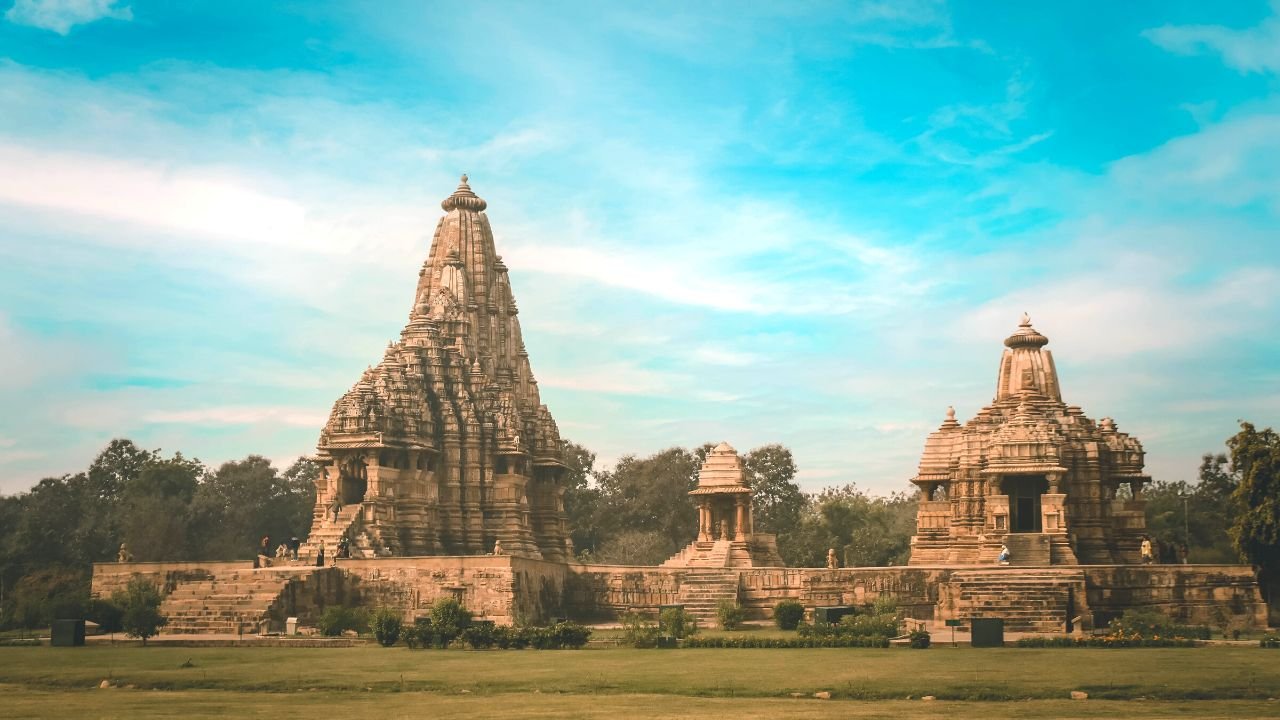





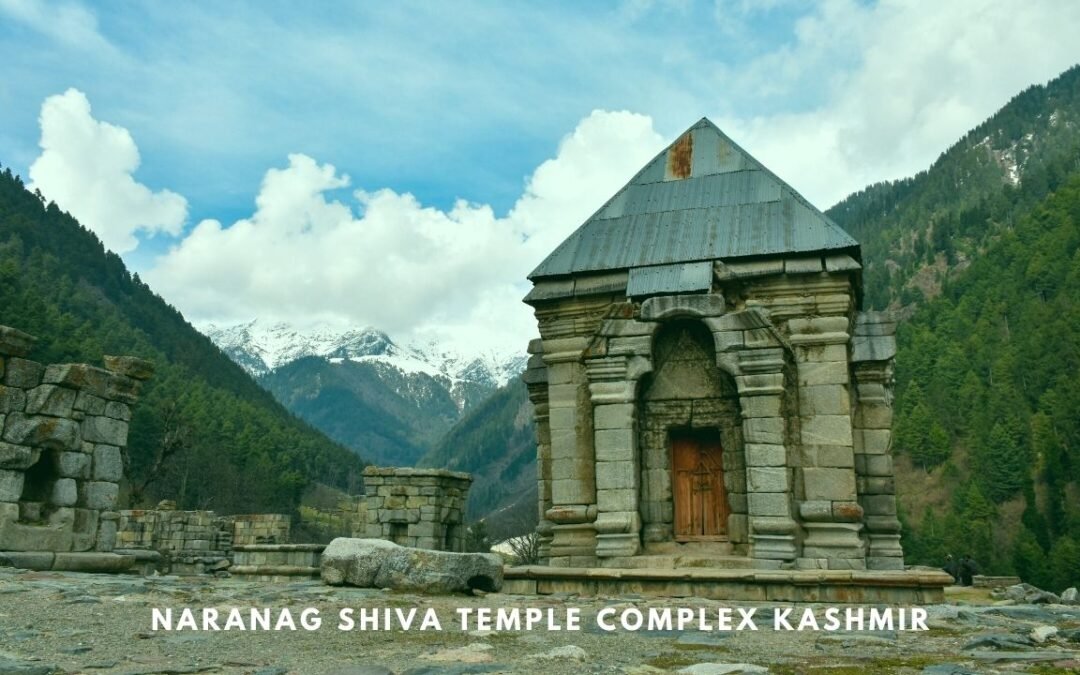

0 Comments